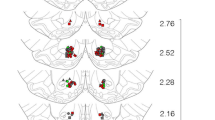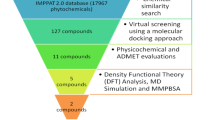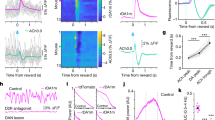Abstract
Amylin is a peptide co-secreted with insulin that penetrates into the brain, and produces satiation-like effects via actions in the brainstem, hypothalamus, and mesencephalon. Little is known, however, about the effects of amylin in the nucleus accumbens shell (AcbSh), where a circumscribed zone of intense amylin receptor (AMY-R) binding overlaps reported mappings of a ‘hotspot’ for μ-opioid receptor (μ-OR) amplification of food reward. Here, the ability of intra-AcbSh AMY-R signaling to modulate μ-OR-driven feeding was explored. Amylin (1–30 ng) was administered with the μ-OR agonist, D-Ala2, N-MePhe4, Gly-ol]-enkephalin (DAMGO) (0.25 μg), directly into the AcbSh of ad libitum-maintained rats. Amylin dose-dependently reversed DAMGO-induced hyperphagia; 3 ng of amylin reduced DAMGO-mediated feeding by nearly 50%. This dose was, however, completely ineffective at altering DAMGO-induced feeding in the anterior dorsal striatum. Intra-AcbSh amylin alone (3–30 ng) modestly suppressed 10% sucrose intake in ad libitum-maintained rats, and chow in food-deprived rats, but only at the 30-ng dose. This result indicates that reversal of AcbSh DAMGO-induced feeding at a 10-fold lower dose was neither due to malaise nor motoric impairment. Finally, intra-AcbSh infusion of the AMY-R antagonist, AC187 (20 μg), significantly attenuated the ability of prefeeding to suppress DAMGO-induced food intake, with no effects in non-prefed rats. Hence, AMY-R signaling negatively modulates μ-OR-mediated appetitive responses at the level of the AcbSh. The results with AC187 indicate that endogenous AMY-R transmission in the AcbSh curtails opioid function in the postprandial period, suggesting a novel pathway for peripheral-central integration in the control of appetitive motivation and opioid reward.
Similar content being viewed by others
Log in or create a free account to read this content
Gain free access to this article, as well as selected content from this journal and more on nature.com
or
References
Ahren B, Sundler F (1992). Localization of calcitonin gene-related peptide and islet amyloid polypeptide in the rat and mouse pancreas. Cell Tissue Res 269: 315–322.
Alam T, Chen L, Ogawa A, Leffert JD, Unger RH, Luskey KL (1992). Coordinate regulation of amylin and insulin expression in response to hypoglycemia and fasting. Diabetes 41: 508–514.
Arnelo U, Reidelberger R, Adrian TE, Larsson J, Permert J (1998). Sufficiency of postprandial plasma levels of islet amyloid polypeptide for suppression of feeding in rats. Am J Physiol 275: R1537–R1542.
Baisley SK, Bremer QZ, Bakshi VP, Baldo BA (2014). Antipsychotic-like actions of the satiety peptide, amylin, in ventral striatal regions marked by overlapping calcitonin receptor and RAMP-1 gene expression. J Neurosci 34: 4318–4325.
Bakshi VP, Kelley AE (1993). Striatal regulation of morphine-induced hyperphagia: an anatomical mapping study. Psychopharmacology (Berl) 111: 207–214.
Baldo BA, Kelley AE (2001). Amylin infusion into rat nucleus accumbens potently depresses motor activity and ingestive behavior. Am J Physiol Regul Integr Comp Physiol 281: R1232–R1242.
Banks WA, Kastin AJ (1998). Differential permeability of the blood-brain barrier to two pancreatic peptides: insulin and amylin. Peptides 19: 883–889.
Beaumont K, Kenney MA, Young AA, Rink TJ (1993). High affinity amylin binding sites in rat brain. Mol Pharmacol 44: 493–497.
Berner LA, Bocarsly ME, Hoebel BG, Avena NM (2011). Pharmacological interventions for binge eating: lessons from animal models, current treatments, and future directions. Curr Pharm Des 17: 1180–1187.
Bouali SM, Wimalawansa SJ, Jolicoeur FB (1995). In vivo central actions of rat amylin. Regul Pept 56: 167–174.
Butler PC, Chou J, Carter WB, Wang YN, Bu BH, Chang D et al (1990). Effects of meal ingestion on plasma amylin concentration in NIDDM and nondiabetic humans. Diabetes 39: 752–756.
Chance WT, Balasubramaniam A, Zhang FS, Wimalawansa SJ, Fischer JE (1991). Anorexia following the intrahypothalamic administration of amylin. Brain Res 539: 352–354.
Christopoulos G, Paxinos G, Huang XF, Beaumont K, Toga AW, Sexton PM (1995). Comparative distribution of receptors for amylin and the related peptides calcitonin gene related peptide and calcitonin in rat and monkey brain. Can J Physiol Pharmacol 73: 1037–1041.
Davis CA, Levitan RD, Reid C, Carter JC, Kaplan AS, Patte KA et al (2009). Dopamine for ‘wanting’ and opioids for ‘liking’: a comparison of obese adults with and without binge eating. Obesity (Silver Spring) 17: 1220–1225.
Denbleyker M, Nicklous DM, Wagner PJ, Ward HG, Simansky KJ (2009). Activating mu-opioid receptors in the lateral parabrachial nucleus increases c-Fos expression in forebrain areas associated with caloric regulation, reward and cognition. Neuroscience 162: 224–233.
DiFeliceantonio AG, Mabrouk OS, Kennedy RT, Berridge KC (2012). Enkephalin surges in dorsal neostriatum as a signal to eat. Curr Biol 22: 1918–1924.
Hay DL, Christopoulos G, Christopoulos A, Poyner DR, Sexton PM (2005). Pharmacological discrimination of calcitonin receptor: receptor activity-modifying protein complexes. Mol Pharmacol 67: 1655–1665.
Kelley AE, Baldo BA, Pratt WE (2005). A proposed hypothalamic-thalamic-striatal axis for the integration of energy balance, arousal, and food reward. J Comp Neurol 493: 72–85.
Kelley AE, Bless EP, Swanson CJ (1996). Investigation of the effects of opiate antagonists infused into the nucleus accumbens on feeding and sucrose drinking in rats. J Pharmacol Exp Ther 278: 1499–1507.
Kim EM, Quinn JG, Levine AS, O’Hare E (2004). A bi-directional mu-opioid-opioid connection between the nucleus of the accumbens shell and the central nucleus of the amygdala in the rat. Brain Res 1029: 135–139.
Koch JE, Glass MJ, Cooper ML, Bodnar RJ (1995). Alterations in deprivation, glucoprivic and sucrose intake following general, mu and kappa opioid antagonists in the hypothalamic paraventricular nucleus of rats. Neuroscience 66: 951–957.
Kruger L, Mantyh PW, Sternini C, Brecha NC, Mantyh CR (1988). Calcitonin gene-related peptide (CGRP) in the rat central nervous system: patterns of immunoreactivity and receptor binding sites. Brain Res 463: 223–244.
Lutz TA, Mollet A, Rushing PA, Riediger T, Scharrer E (2001). The anorectic effect of a chronic peripheral infusion of amylin is abolished in area postrema/nucleus of the solitary tract (AP/NTS) lesioned rats. Int J Obes Relat Metab Disord 25: 1005–1011.
Lutz TA, Rossi R, Althaus J, Del Prete E, Scharrer E (1997). Evidence for a physiological role of central calcitonin gene-related peptide (CGRP) receptors in the control of food intake in rats. Neurosci Lett 230: 159–162.
Lutz TA, Rossi R, Althaus J, Del Prete E, Scharrer E (1998a). Amylin reduces food intake more potently than calcitonin gene-related peptide (CGRP) when injected into the lateral brain ventricle in rats. Peptides 19: 1533–1540.
Lutz TA, Senn M, Althaus J, Del Prete E, Ehrensperger F, Scharrer E (1998b). Lesion of the area postrema/nucleus of the solitary tract (AP/NTS) attenuates the anorectic effects of amylin and calcitonin gene-related peptide (CGRP) in rats. Peptides 19: 309–317.
Marrazzi MA, Bacon JP, Kinzie J, Luby ED (1995). Naltrexone use in the treatment of anorexia nervosa and bulemia nervosa. Int Clin Psychopharmacol 10: 163–172.
Mietlicki-Baase EG, Rupprecht LE, Olivos DR, Zimmer DJ, Alter MD, Pierce RC et al (2013). Amylin receptor signaling in the ventral tegmental area is physiologically relevant for the control of food intake. Neuropsychopharmacology 38: 1685–1697.
Mollet A, Gilg S, Riediger T, Lutz TA (2004). Infusion of the amylin antagonist AC 187 into the area postrema increases food intake in rats. Physiol Behav 81: 149–155.
Moore CX, Cooper GJ (1991). Co-secretion of amylin and insulin from cultured islet beta-cells: modulation by nutrient secretagogues, islet hormones and hypoglycemic agents. Biochem Biophys Res Commun 179: 1–9.
Morfis M, Tilakaratne N, Furness SG, Christopoulos G, Werry TD, Christopoulos A et al (2008). Receptor activity-modifying proteins differentially modulate the G protein-coupling efficiency of amylin receptors. Endocrinology 149: 5423–5431.
Morley JE, Flood JF (1991). Amylin decreases food intake in mice. Peptides 12: 865–869.
Ogawa A, Harris V, McCorkle SK, Unger RH, Luskey KL (1990). Amylin secretion from the rat pancreas and its selective loss after streptozotocin treatment. J Clin Invest 85: 973–976.
O’Brien CP (2005). Anticraving medications and relapse prevention: a possible new class of psychoactive medications. Am J Psychiat 162: 1423–1431.
Paxinos G, Watson C (2007). The rat brain in stereotaxic coordinates, 6th edn, Academic Press.
Pecina S, Berridge KC (2005). Hedonic hot spot in nucleus accumbens shell: where do mu-opioids cause increased hedonic impact of sweetness? J Neurosci 25: 11777–11786.
Perry ML, Baldo BA, Andrzejewski ME, Kelley AE (2009). Muscarinic receptor antagonism causes a functional alteration in nucleus accumbens mu-opiate-mediated feeding behavior. Behav Brain Res 197: 225–229.
Poyner DR, Sexton PM, Marshall I, Smith DM, Quirion R, Born W et al (2002). International Union of Pharmacology. XXXII. The mammalian calcitonin gene-related peptides, adrenomedullin, amylin, and calcitonin receptors. Pharmacol Rev 54: 233–246.
Rushing PA, Hagan MM, Seeley RJ, Lutz TA, Woods SC (2000). Amylin: a novel action in the brain to reduce body weight. Endocrinology 141: 850–853.
Sexton PM, Paxinos G, Kenney MA, Wookey PJ, Beaumont K (1994). In vitro autoradiographic localization of amylin binding sites in rat brain. Neuroscience 62: 553–567.
Singh-Franco D, Perez A, Harrington C (2011). The effect of pramlintide acetate on glycemic control and weight in patients with type 2 diabetes mellitus and in obese patients without diabetes: a systematic review and meta-analysis. Diabetes Obes Metab 13: 169–180.
Smith KS, Berridge KC (2007). Opioid limbic circuit for reward: interaction between hedonic hotspots of nucleus accumbens and ventral pallidum. J Neurosci 27: 1594–1605.
Stratford TR, Kelley AE (1997). GABA in the nucleus accumbens shell participates in the central regulation of feeding behavior. J Neurosci 17: 4434–4440.
van Rossum D, Hanisch UK, Quirion R (1997). Neuroanatomical localization, pharmacological characterization and functions of CGRP, related peptides and their receptors. Neurosci Biobehav Rev 21: 649–678.
van Rossum D, Menard DP, Fournier A, St-Pierre S, Quirion R (1994). Autoradiographic distribution and receptor binding profile of [125I]Bolton Hunter-rat amylin binding sites in the rat brain. J Pharmacol Exp Ther 270: 779–787.
Williams JT, Ingram SL, Henderson G, Chavkin C, von Zastrow M, Schulz S et al (2013). Regulation of mu-opioid receptors: desensitization, phosphorylation, internalization, and tolerance. Pharmacol Rev 65: 223–254.
Woolley JD, Lee BS, Fields HL (2006). Nucleus accumbens opioids regulate flavor-based preferences in food consumption. Neuroscience 143: 309–317.
Zhang M, Kelley AE (1997). Opiate agonists microinjected into the nucleus accumbens enhance sucrose drinking in rats. Psychopharmacology (Berl) 132: 350–360.
Zhang M, Kelley AE (2000). Enhanced intake of high-fat food following striatal mu-opioid stimulation: microinjection mapping and Fos expression. Neuroscience 99: 267–277.
Ziauddeen H, Chamberlain SR, Nathan PJ, Koch A, Maltby K, Bush M et al (2013). Effects of the mu-opioid receptor antagonist GSK1521498 on hedonic and consummatory eating behaviour: a proof of mechanism study in binge-eating obese subjects. Mol Psychiatry 18: 1287–1293.
Acknowledgements
This work was supported by R21 MH093824 (BAB), and SKB was supported by training grant T32 GM007507. We are grateful to Ken Sadeghian and Ryan Selleck for technical assistance. Facilities and procedures complied with animal use and care guidelines from the National Institutes of Health of the USA, and were approved by the Institutional Animal Care and Use Committee of the University of Wisconsin.
Author information
Authors and Affiliations
Corresponding author
Rights and permissions
About this article
Cite this article
Baisley, S., Baldo, B. Amylin Receptor Signaling in the Nucleus Accumbens Negatively Modulates μ-opioid-Driven Feeding. Neuropsychopharmacol 39, 3009–3017 (2014). https://doi.org/10.1038/npp.2014.153
Received:
Revised:
Accepted:
Published:
Issue date:
DOI: https://doi.org/10.1038/npp.2014.153
This article is cited by
-
Effects of sub-chronic amylin receptor activation on alcohol-induced locomotor stimulation and monoamine levels in mice
Psychopharmacology (2020)
-
An amylin analogue attenuates alcohol-related behaviours in various animal models of alcohol use disorder
Neuropsychopharmacology (2019)



